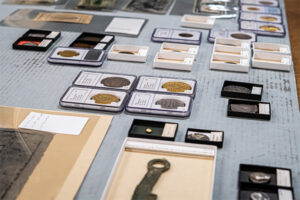By Public Affairs Office Staff
November 9, 2023

On an early fall day in Washington, DC, members of the U.S. Mint’s Public Affairs team visited the National Numismatic Collection at the Smithsonian’s National Museum of American History. As one of the most popular museums on the National Mall, it welcomes millions of visitors per year to view the greatest single collection of American history in the world.
The museum holds some of our nation’s most important historical artifacts, spanning science, political history, and popular culture. Naturally, it is the home of the biggest coin collection in America and one of the largest in the world – containing over 1.6 million objects. The collection is a public resource and available for research visits.
Recently, the Mint team requested a viewing of early American coins, which were formerly part of the Mint’s own historic archive, called “the Mint Cabinet.” The Cabinet contained coinage from colonial America all the way through the 20tth century and was transferred to the Smithsonian Institution in 1923. Considered to be one of the most complete collections of American coinage, the Cabinet included over 18,000 coins and medals.
The Collection is stored at the museum in an organized and temperature-controlled environment. Dr. Ellen Feingold, curator of the National Numismatic Collection, welcomed the Mint team and led the research visit.
Jennifer Gloede, collections manager, pulled out around two dozen coins and banknotes for review, ranging from the ancient world to the 20th century. The objects range in their condition because, as Jennifer explained, the museum staff preserves items to reflect their history. Items are not cleaned up to be pristine. The collection is cared for and stored in ways to prevent future damage, holding onto the characteristics that make each object unique and of its time.
The objects were arranged in chronological order, beginning with what is considered one of the earliest form of coins – Chinese knife-shaped pieces from 5th century BCE. The earliest form of paper notes also dates back to China in the 14th century and the collection hosts one of the oldest examples. Other ancient pieces included a tiny Lydian coin made of electrum, a natural occurring metal, and coins featuring detailed depictions of Greek goddesses.
Moving forward in time, Jennifer and Ellen showed examples of more modern coinage from the 18th century. These coins highlighted how coin design and production advanced over time. An intricate German thaler showed how coin makers could mint more complex designs. A 19th century platinum Russian coin is an example of how mints began to experiment with the use of different metals.
The visit shifted to focus on historic American coins, undoubtedly once part of the Mint Cabinet. Tracing the history of coins in America, Ellen explained that Spanish dollars were widely used in early colonial America in the absence of a standard monetary system.
Early examples of colonial money showed how each colony represented their own local culture in the design of their money. Ellen explained that the Massachusetts Pine Tree Shilling design ties directly back to an important export of the Massachusetts colony: pine trees for ship’s masts.
After the Revolutionary War, the United States began to shift towards a unified currency. The Fugio cent, which was the first national coin minted in America, is named such because of the inscription “Fugio” on the reverse. These coins were only produced under the Articles of Confederation for a short time.
Later, the U.S. Mint began officially producing coins after the ratification of the Coinage Act of 1792. One of the earliest and most unique coins is a 1792 half dime – a coin much smaller than any in use today – made before the completion of the Mint’s building in Philadelphia. The Numismatic collection has prime examples of the Mint’s first coins, including the 1793 Flowing Hair cent, silver coins from 1794, and gold coins from 1795.
Among these coins, another interesting piece of Mint history was also on view: pattern coins. These are produced as a test to see how design, metal composition, or other changes impact a coin. Because coins are so small, even a very small change can make a big difference to the overall look and feel. An amazing example is the 1907 Double Eagle ultra high relief pattern coin created by the Mint to test the minting of a new design by sculptor Augustus Saint-Gaudens. Ellen pointed out that this pattern coin shows a sculptor’s perspective in the way Saint-Gaudens intended.
While anyone can request to view the collection in Washington, DC, only some of the coins are digitized on the museum’s website. Ellen and her colleagues would love to give broader access to this collection, especially the American money. As resources become available, the team will digitize more of these important parts of the American story.
In addition to the National Numismatic Collection, the museum has two public exhibits featuring numismatic objects. Visitors can explore the history and cultural impact of money in an exhibit called “The Value of Money.” For younger visitors, the “Really Big Money” exhibit showcases the history of money from around the world with multiple interactive components. Both of these also have virtual exhibitions.
The ability to see early American coins close up deepens understanding, creating a direct line between the present and the past. It underscores a key point Ellen shared: coins are a reflection of the people, place, and culture from which they are made. The early American coins show the young nation as one trying to define itself, and in the end, those early Americans did well. Afterall, many of the symbols, words, and features they chose are still on American coins today.
See more Inside the Mint articles.


